
Chromodoris mandapamensis
Valdés, Mollo & Ortea, 1999
Order: NUDIBRANCHIA
Suborder: DORIDINA
Superfamily: EUDORIDOIDEA
Family: Chromodorididae
PHOTO
Mandapam, Tamil Nadu, India, May 1998, 30 mm long preserved. Photo: E. Mollo.
RELATED TOPIC
This species is characterized by having a cream to pale gray background color, with the entire dorsum densely covered with numerous, rounded dark brown spots. These spots appear to be diffuse in the mantle edge. A broken line of bright orange spots edges the mantle margin. There are several, ramified, subepidermical matle glands around the mantle margin. The rhinophore stalks are cream with several dark brown spots. The clubs are brown, with white edged lamellae. The apexes are reddish with white tips. The perfoliate rhinophores are composed of 17 lamellae. The gill consists of seven large, bipinnate branchial leaves. The leaves are pale brown with numerous, small opaque white dots scattered all over the surface, and large brown spots near the base of the leaves.
The name of this species is derived from Mandapam, the type locality. So far, it is only known from Mandapam (Tamil Nadu) and Muttom (Kerala), southern India.
Reference:
• Valdés, A., Mollo, E. & Ortea, J. (1999) Two new species of Chromodoris (Mollusca, Nudibranchia, Chromodorididae) from Southern India, with a redescription of Chromodoris trimarginata (Winckworth, 1946). Proceedings of the California Academy of Sciences, 51: 461-472.
NOTE: This species may be a colour form of C. striatella. See my discussion on the C. striatella - spotted form Page. See photo of intermediate colour form. - W.B.Rudman.
Authorship detailsValdes, A., 2000 (July 23) Chromodoris mandapamensis Valdés, Mollo & Ortea, 1999. [In] Sea Slug Forum. Australian Museum, Sydney. Available from http://www.seaslugforum.net/find/chromand
Related messages
Re: Chromodoris mandapamensis from Thailand
August 18, 2008
From: Lawrence Neal
Concerning message #21805:
Hi Bill,
Thanks very much for sharing your knowledge. You're absolutely right, I didn't notice the Doriopsis when photographing the egg ribbon or when looking at the photograph later. Let's say the Doriopsis is well camouflaged, to say the least. And it certainly takes us back to square one regarding food/eggs of C. mandapamensis. Anyway, at least I can go back and know what to look out for now.
Lawrence
lorenzo_n@yahoo.com
Neal, L., 2008 (Aug 18) Re: Chromodoris mandapamensis from Thailand. [Message in] Sea Slug Forum. Australian Museum, Sydney. Available from http://www.seaslugforum.net/find/21812Dear Lawrence,
Yes it would have been nice to get a food sponge for C. mandapamensis, but Doriopsis is always an interesting find. What alerted me was the particular shade of blue. Although both the sponge Terpios and Doriopsis can range in colour, I don't know of anything else that can be this shade of dark blue. Of course now I have said that, I hope I will not be flooded with other things of the same colour. Suffice to say, when I see that blue, my first thoughts are Terpios and Doriopsis.
Best wishes,
Bill Rudman
Re: Chromodoris mandapamensis from Thailand
August 15, 2008
From: Lawrence Neal
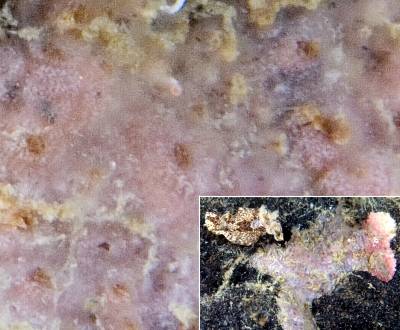
Concerning message #21788:
Hi Bill,
I attached a picture of the pink sponge which could be the food of the C. mandapamensis, as you requested. Not sure how sharp it is as I was only interested in focussing on the slug (that's what you get from an amateur naturalist). Incidentally, the black background is a rubber tyre which forms part of the jetty structure.
Locality: Saphan Tawaen, Koh Larn, Pattaya, 8 metres, Chonburi, Thailand, Gulf of Thailand, South China Sea, 10 August 2008, Jetty. Length: 25 mm. Photographer: Lawrence Neal.
I also attached a picture of an egg ribbon that was about 6 inches away from the animal (diameter of the ribbon was approx. 20 mm). I know this is probably too circumstantial to draw any firm conclusions. However, it's worth noting that this dive site has very few Nudibranchs (but lots of flatworms). We have only seen 2 species over several dives at the site - the C. mandapamensis and a couple of Risbecia tryoni, which are in a different size class. So I think there's a strong possibility that the egg ribbon came from this animal. Anyway, I'll try to revisit the site soon and see if I can come up with some more pictures.
Best regards,
Lawrence
lorenzo_n@yahoo.com

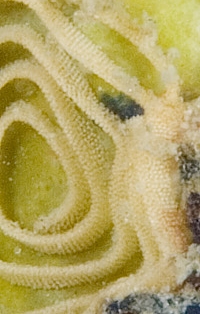
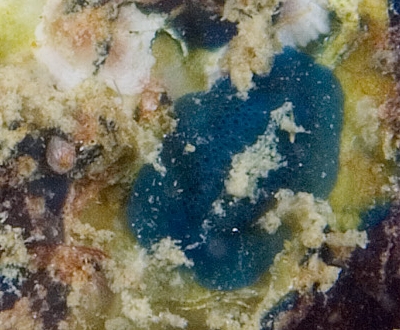
Dear Lawrence,
Thanks for these photos. When I saw your first message I thought the sponge could have been an aplysillid, which is a sponge family which many species of Chromodoris feed on. However after looking at these photos - and the 'egg photo' has a big colony of the pink sponge as well - I am pretty sure it is a sponge with siliceous spicules and most unlikely to be the food of a Chromodoris.
Your egg ribbon photo is quite interesting and contains a nudibranch you hadn't noticed: if you look to the right of the egg ribbon there is a blue object which I have enlarged in the photo alongside my comments. It is the blue form of Doriopsis granulosa and I am pretty sure the eggs belong to it, and the yellow sponge [?Prianos sp.] is its food. As I discuss on the species' Fact Sheet there is a second species, Doriopsis pecten, which is also dark blue which feeds on a dark blue sponge [Terpios sp]. Identifying the two species can be quite difficult because D. granulosa ranges in colour from yellow, to green and the same dark blue as D. pecten. As both food sponges seem to be found together, finding a blue Doriopsis next to a blue sponge does not necessarily mean it must be D. pecten [see message #9351]. Looking carefully at your 'egg ribbon' photo there are quite a few blue objects present but most I cannot identify as sponge or dorid, except for the one on the right of the egg ribbon and probably the one at the upper left. All the others could well be sponge colonies. The reason I suspect the dorid is D. granulosa, is that we know its egg ribbon is the shape and colour of the one in your photo. The egg ribbon of D. pecten is smaller, white, and has a ruffled edge [message #9368]
Best wishes,
Bill Rudman
Chromodoris mandapamensis from Thailand
August 14, 2008
From: Lawrence Neal

Hi Bill,
I wonder if you could help with an ID for this slug? It was found under a jetty on a sponge-encrusted pile, about 8 metres deep. It's the first time I've seen it in the area. Perhaps the white-spotted gills could be an identifying feature?
I'm not sure but it looks as though the mantle may have been damaged - an encounter with a fish maybe.
Locality: Saphan Tawaen, Koh Larn, Pattaya, 8 metres, Chonburi, Thailand, Gulf of Thailand, South China Sea, 10 August 2008, Jetty. Length: 25 mm. Photographer: Lawrence Neal.
Really appreciate your help and your website.
Lawrence
lorenzo_n@yahoo.com

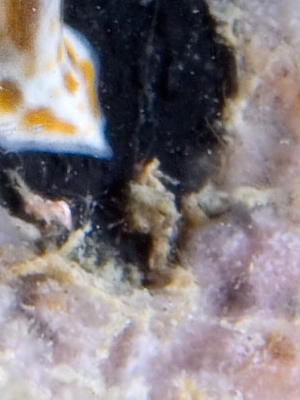

Dear Lawrence,
This is Chromodoris mandapamensis, which I suspect, as you will see on the species' Fact Sheet, is probably just a spotted form of C. striatella. I am interested in the pinkish sponge in the bottom right of the upper photo, which seems to have a bit eaten out of it. If you have a photo which shows the sponge more clearly I would be interested in seeing it.
Best wishes,
Bill Rudman
Re: Chromodoris striatella with some spots
July 25, 2008
From: Jean-François Hervé

Concerning message #9861:
Dear Bill
In an earlier message, you tell us that your C. mandapamensis photos from New Caledonia failed. I send you what I believe is a Chromodoris mandapamensis. I hope they can help us to make sense between C. mandapamensis, C. burni and C. striatella...
Locality: Noumea, 10 m, New Caledonia, Pacific Ocean, 2007, muddy. Length: 3 cm. Photographer: Jean-François Hervé.
Kind regards
Jean-François Hervé
jfherve@free.fr
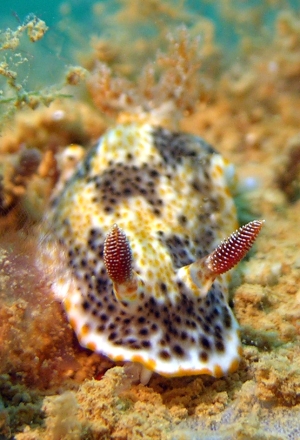
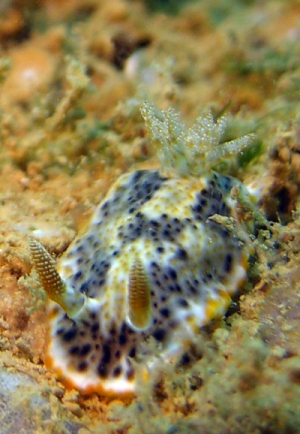
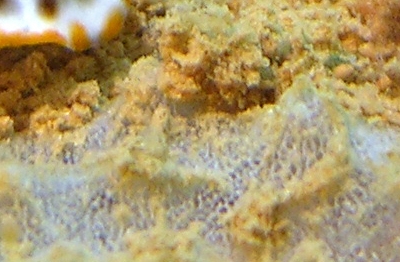
Dear Jean-François,
It was not my photos of C. mandapamensis that failed but photos of animals from New Caledonia which had both black lines and black spots and in my opinion show that C. mandapamensis is a spotted form of C. striatella. In fact Robert Sozzani's photo in the message you refer to shows exactly this.
I am placing your message with C. mandapamensis, but at the risk of sounding like a squeaky wheel, I suspect it is a form of C. striatella. One interesting feature in your photo is the bluish sponge in the foreground. It seems to be part of a larger colony partly covered by algae or detritus. Unfortunately I can't see enough detail to be sure of its identity, and of course we can't even be sure it is feeding, but I think it is worth drawing attention to it in case we later find this species feeding on the same sponge.
Best wishes,
Bill Rudman
Chromodoris mandapamensis from Nhatrang, Vietnam
July 4, 2008
From: Hua Thai Tuyen
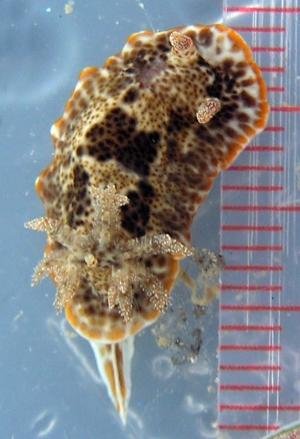
I need someone to help.
Locality: Nhatrang, 3 metres, Vietnam, 09 May 2008. Length: 20 mm
Hua Thai Tuyen
hthaituyen@yahoo.com
Tuyen, H.T., 2008 (Jul 4) Chromodoris mandapamensis from Nhatrang, Vietnam. [Message in] Sea Slug Forum. Australian Museum, Sydney. Available from http://www.seaslugforum.net/find/21674Dear Tuyen,
This chromodorid has been named Chromodoris mandapamensis, but as I discuss on a separate page I think this is a spotted form of Chromodoris striatella.
Best wishes,
Bill Rudman
Chromodoris mandapamensis feeding ?
February 15, 2007
From: Colin Ogden

Hi Bill,
The other day I came across a Chromodoris mandapamensis that appeared to be feeding. I know we are looking for some pictures of what type of sponge they are feeding on. After taking the upper photo I moved its head and tried to get a picture of the area it was interested in. I can not determine what it was feeding on from my photos. It appears to be something small hidden under the growth. This seems to be the case with all the photos we try to get of this animal feeding. I am sending you these pictures in the hope that you can find something I have overlooked.
Locality: Sodwana Bay, 19 metres, South Africa, Indian, 13 January 2007, reef. Length: 45 mm. Photographer: Colin Ogden
Regards
Colin
scubaco@iafrica.com
Ogden C. M., 2007 (Feb 15) Chromodoris mandapamensis feeding ?. [Message in] Sea Slug Forum. Australian Museum, Sydney. Available from http://www.seaslugforum.net/find/19457
Dear Colin,
Thanks for persevering with this mystery. All I can say is that some day you must have success. I looked closely at your original photos (which I have cropped a bit) and could find no sign of a sponge. If this species is, as I suspect, a colour form of C. striatella then I would suspect that like that species, it will be feeding on a darwinellid sponge [see earlier message [#9559 and Fact Sheet]. It should also have a flat egg ribbon [message #19123 ].
Good luck,
Bill Rudman
Re: Chromodoris mandapamensis feeding
March 8, 2006
From: Colin Ogden
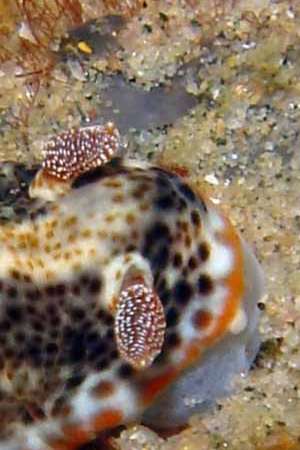
Concerning message #16024
Hi Bill,
here is another photo of the C. mandapamensis from a different angle which I believe shows that the pebble next to it is separate from its oral system. I didn't notice the position of the pebble in the first photo I sent which just shows how precise we have to be in making assumptions. Unfortunately a sighting of these nudi's here is extremely rare.
Locality: Sodwana Bay, 19 m, South Africa, Indian, Feb 2006, Coral Reef. Length: 40mm. Photographer: Nicola Orban.
regards
Colin
scubaco@iafrica.com
Ogden C. M., 2006 (Mar 8) Re: Chromodoris mandapamensis feeding. [Message in] Sea Slug Forum. Australian Museum, Sydney. Available from http://www.seaslugforum.net/find/16050Dear Colin,
It was fortunate that Nicola took a photo from this angle - and remarkable how similar in colour the stone and the oral tube is. The sad thing now is that we can't see what it is eating. I suspect it must have been a very small colony of some sponge which it has completely enveloped. Let's hope it is not so rare that you or your team never see it again
Best wishes,
Bill Rudman
Chromodoris mandapamensis feeding
March 7, 2006
From: Colin Ogden
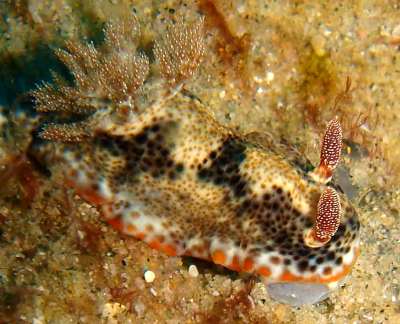
Hi Bill,
One of my staff instructors took this picture the other day, I believe it is a C. mandapamensis, and as I know you are currently doing some work on this, I hope this will help.
Locality: Sodwana Bay, 18 m, South Africa, Indian, Feb 2006, coral reef. Length: 35mm. Photographer: Nicola Orban.
Regards
Colin
scubaco@iafrica.com
Ogden C. M., 2006 (Mar 7) Chromodoris mandapamensis feeding. [Message in] Sea Slug Forum. Australian Museum, Sydney. Available from http://www.seaslugforum.net/find/16024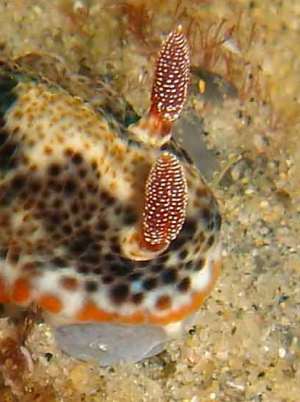
Dear Colin,
Thanks for thinking of me. I would very much like to know what this species is feeding on at what type of egg ribbon it has. Unfortunately I don't think this photo shows the animal feeding, I have looked at this photo many times - and in the higher resolution scan you sent - and I am afraid I think the bluish white 'lump' under the head, that certainly looks like an extended oral tube, is actually part of a smooth stone in the sand. I am pretty sure I can see part of it above the head and out in front of the head.
Please keep on looking. I am sure - and hope - that it is only a matter of time
Best wishes,
Bill Rudman
Chromodoris mandapamensis in aquarium sump
January 26, 2006
From: Chris King
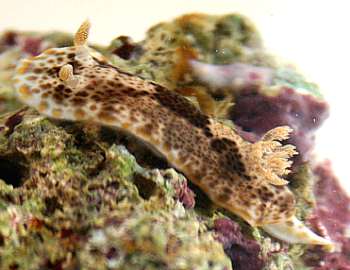
found in my sump
chrisking666@hotmail.com
King, C., 2006 (Jan 26) Chromodoris mandapamensis in aquarium sump. [Message in] Sea Slug Forum. Australian Museum, Sydney. Available from http://www.seaslugforum.net/find/15647Dear chris,
Normally I wouldn't bother with your message as it has no information or even normal greetings. The Forum is not some automatic answering and identification machine - there are real people involved who volunteer their time to share information about these fascinating animals. I'm afraid 'found in my sump' may be how you would talk to a computer but I would prefer to be talked to as a friendly human.
However your photo won the day. It is of an interesting animal which has been named Chromodoris mandapamensis. As you will find on that Fact Sheet, I suspect this species is a spotted colour form of Chromodoris striatella, so any more photos we can get are valuable as they may in time help resolve the issue. How did it get in your sump? You don't say how large your animal is but I guess it got into your tank on some 'live rock'. Perhaps its preferred sponge was also on the rock so it could feed for a while, but I suspect if you have kept it, its future is starvation.
Best wishes,
Bill Rudman
Re: Chromodoris mandapamensis feeding?
October 6, 2005
From: Colin Ogden

Hi Bill,
Thanks for your quick response [#14920]. I do have another photo of the Chromodoris. Unfortunately it is not a good one, but I do think it might have its mouth extended, but whether it is feeding on the sponge or on something in the sand, I don't know.
Locality: Sodwana Bay, South Africa, Indian Ocean coast. Depth: 9 meters.
Length: 4 cm 3 October 2005. Algae/sponge reef. Photographer: Colin Ogden
Also can the photo give more info about the sponge?
I hope this helps
regards
Colin
scubaco@iafrica.com
Ogden, C., 2005 (Oct 6) Re: Chromodoris mandapamensis feeding?. [Message in] Sea Slug Forum. Australian Museum, Sydney. Available from http://www.seaslugforum.net/find/14931Dear Colin,
The quick response was because I am trying to finish a manuscript and evrytime I do, I get sent a new tantalising addition. Your photo doesn't show the sponge any better but it does show the buccal bulb extended, indicative of feeding. As I said earlier, I have been pretty sure that C. mandapamensis is a spotted from of C. striatella, but your photo may suggest differently. The only records I have of C. striatella feeding, are some observations of my own of it on species of Darwinella. I am pretty sure your orange sponge is from a quite unrelated family, which would suggest the two chromodorids are different. What I need now is some more observations of both the species feeding to confirm these differences. As I said earlier - a very tantalising find.
Best wishes,
Bill Rudman
Unidentified Chromodoris from South Africa
October 5, 2005
From: Colin Ogden
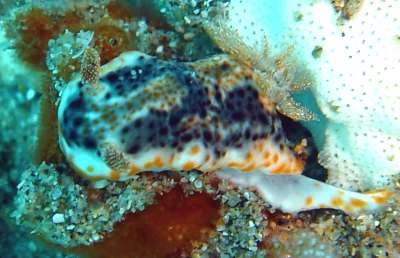
Hi Bill,
Another new nudi that I can't find ID for.
I think its a Chromodoris.
Locality: Sodwana Bay, South Africa. Indian Ocean coast. Depth: 10 metres. Length: 30 mm. 3 October 2005. Algae reef. Photographer: Colin Ogden
Thanks for you help
regards
Colin
scubaco@iafrica.com
Ogden C. M., 2005 (Oct 5) Unidentified Chromodoris from South Africa. [Message in] Sea Slug Forum. Australian Museum, Sydney. Available from http://www.seaslugforum.net/find/14920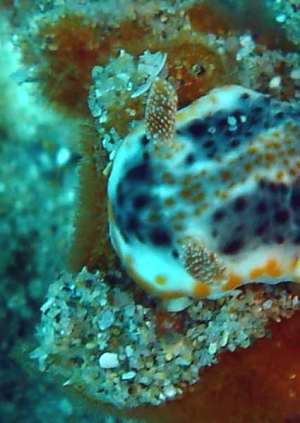
Dear Colin,
This has been named Chromodoris mandapamensis, but as I have discussed on the Forum before I think it is a spotted colour form of C. striatella. [see message #2841]. I am not sure, but the orange-red sponge in the background of your photo looks interesting. I can't see any direct evidence of feeding but it would be worth noting the possible association. You wouldn't by chance have a photo showing the sponge more clearly - even if the slug is not so clear?
Best wishes,
Bill Rudman
Chromodoris mandapamensis? from Thailand
September 27, 2005
From: Nararongpon Sittithaweepat
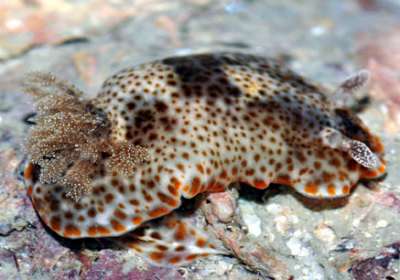
Dear Dr Rudman
I am studying nudibranchs at Kasetsart University in Thailand. I cannot identify some of them. I found this one at Mu Koh Angthong National Park. I not sure if it is Chromodoris mandapamensis. Please can you identify it.
Locality: Mu Koh Angthong National Park, Thailand. Gulf of Thailand. Depth: 7 m. Length: 30 mm. 10 August 2005.dead coral. Photographer: Narongpon Sittithaweepat
Thank you for your kindness
Narongpon Sittithaweepat
dorid44@yahoo.com
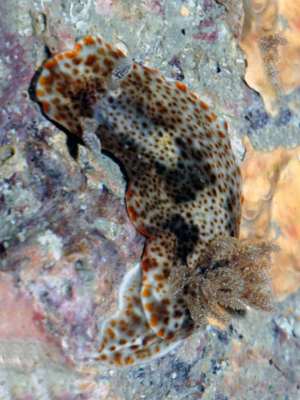
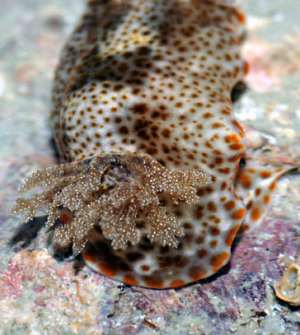
Dear Narongpon,
Yes this is what has been recently named Chromodoris mandapamensis, but as you will see from earlier comments I have made on the Forum I strongly suspect that it is a spotted colour form of Chromodoris striatella. In fact I have found juveniles with spots and lines. If you get the chance to see it feeding or laying eggs, photos would be very useful.
Best wishes,
Bill Rudman
Chromodoris mandapamensis from Myanmar
May 14, 2003
From: Mary Jane Adams
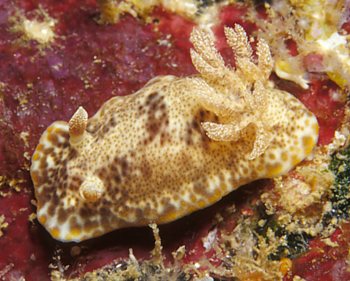
Hi Bill,
I found this nudibranch crawling on a wall at 17 meters at Three Islets, Mergui Archipelago, Andaman Sea, Myanmar on Feb. 27, 2003. It was 18mm long. I knew I had never seen it before, so I asked Angel Valdes if he could ID it. He said it was Chromodoris mandapamensis, which he had described from southern India.
Best regards,
Mary Jane
divepng@yahoo.com
Adams, M.J., 2003 (May 14) Chromodoris mandapamensis from Myanmar. [Message in] Sea Slug Forum. Australian Museum, Sydney. Available from http://www.seaslugforum.net/find/9416Dear Mary Jane,
I agree that this is what Angel described as Chromodoris mandapamensis. However I feel C. mandapamensis is a colour form of C. striatella, and have placed a number of similarly coloured animals on a 'spotted C. striatella' page. I am also posting today a photo from Indonesia of an animal with some lines broken into spots, which seems to me to be pretty good evidence they are the same. I guess only time will tell who's correct.
Cheers,
Bill Rudman
Chromodoris mandapamensis from India
July 25, 2000
From: Ángel Valdés
Dear Bill,
Here is a description and photographs of the recently described Chromodoris mandapamensis and its anatomy. It is only known from it is only known from Mandapam (Tamil Nadu) and Muttom (Kerala), in southern India.
Reference:
Valdés, A., Mollo, E. & Ortea, J. (1999) Two new species of Chromodoris (Mollusca, Nudibranchia, Chromodorididae) from Southern India, with a redescription of Chromodoris trimarginata (Winckworth, 1946). Proceedings of the California Academy of Sciences, 51: 461-472.
Ángel Valdés
avaldes@calacademy.org
Valdés, A., 2000 (Jul 25) Chromodoris mandapamensis from India. [Message in] Sea Slug Forum. Australian Museum, Sydney. Available from http://www.seaslugforum.net/find/2759Dear Angel,
Thanks for information and illustrations, which I have split into two pages, and also for the information on Chromodoris naiki.
Bill Rudman.
